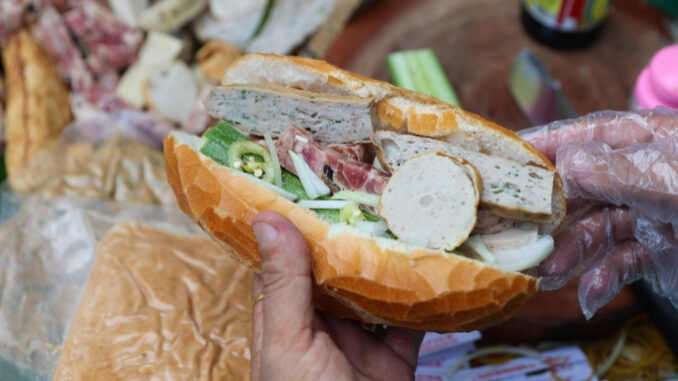
Ly’s bread on the sidewalk of Hai Ba Trung Street, District 3, only has spring rolls and onions, cucumbers, sold in three hours in the morning, 450 loaves a day.
Around 6:00 a.m. every day, people living near the corner of Dien Bien Phu – Hai Ba Trung Street, District 3, see Mr. and Mrs. Nguyen Hoang Quoc Thien, 47 years old, carrying bread to the sidewalk. On a banana leaf-lined tray, there are all kinds of spring rolls, rolls, cucumbers, onions, and soy sauce… Next to it is a basket that is always covered to keep the bread hot and crispy. Few first-timers know this bread has existed for more than 70 years.
A small sign “Bread of Uncle Ly” is hung on a large umbrella to cover the sun and rain. Mr. Ly is the “father” of this bread mother. “Mr. Ly, originally from the North, came to Saigon in the 1950s, making a living by making bread, I am the third generation, and have been selling here for 20 years,” said Mr. , add vegetables to the loaf for waiting guests.

According to Mr. Thien, right from the early days, Mr. Ly brought the flavor of his homeland into the bread dish, which is characterized by the northern varieties of spring rolls. At that time, he sold sandwiches with three types of beef rolls, pork rolls and pork rolls. The filling does not have pate or Southern-style sour food, but adds onions, cucumbers, sprinkles with salt and pepper and soy sauce (soy sauce) depending on the customer’s request.
At that time, Mr. Ly sold bread for a walk with a large bamboo basket and traveled by motorbike. In the 1980s, when he was old, he stopped at the beginning of alley 191 Hai Ba Trung. His cake is simple with a small tray placed on a stool and covered with banana leaves . Guests are mainly employees, students, and students to take away.
“Around the 2000s, he stopped selling. After three generations, the bread is still in the same place and keeps the heirloom taste, the way of wholesale is the same as in the early days,” said Mr. Thien.

On the banana leaf-lined mat are all kinds of spring rolls including spring rolls, including spring rolls, beef rolls, and cinnamon rolls. Spring rolls and spring rolls are made by the family according to their own recipe, and beef rolls are placed in the Ong Ta market, where many Northern migrants live. Northern-style beef patty mixed with dill and grilled instead of wrapped in banana leaves and steamed as usual.
In order to keep the spring rolls fresh, instead of pre-cutting, sellers often cut them when customers buy them. A sandwich with thick slices of pork rolls, cucumber, onion, sprinkled with chili, soy sauce is quickly made in about 30 seconds.
On the morning of November 8, Mr. Nguyen Van Mot stopped by to buy a loaf of bread for breakfast. Knowing the habits of customers, Mr. Thien always adds extra beef jerky every time. Mr. Mot has been eating banh mi for over half a century. The 72-year-old man said that in the 1970s when he was a student at Law School on Duy Tan Street (now Pham Ngoc Thach Street), he often stopped by to buy bread from Mr. amphitheater.
“Over the years, the taste is still the same as in the old days, a loaf of bread with lots of sausages and rolls. I like to eat here because I don’t feel sick, quickly get bored because there is meat or pate, butter. Now once a week when I go. I stopped by here again,” said Mr. Mot.
Pham Ly Tai Loc, a student at the University of Architecture in Ho Chi Minh City, and his friends stopped by to buy bread for breakfast. He said that he had just eaten here for nearly a year because he passed by school and saw many people buying. “I usually buy a full loaf, it’s also quite strange to eat because the taste is different from ordinary bread. I don’t think the sidewalk shop has been around for more than 70 years,” Loc said.

Mr. Thien sells all week, rests on Sunday and is out of stock by about 9:30. Every day his mother sells about 450 loaves, with 40 kg of spring rolls, each loaf costs from 25 to 30,000 VND(1$). The bread is located near tourist attractions such as Notre Dame Cathedral, Nguyen Van Binh Book Street, City Post Office, and Con Rua Lake… Guests can buy it to take away, if they like, they can sit on the sidewalk. Near the shop there are also large coffee shops or water shops.
